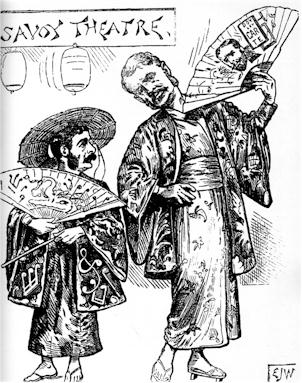|
 "I do not long for all one sees that's Japanese" - Reginald Bunthorne - "Patience"
"I do not long for all one sees that's Japanese" - Reginald Bunthorne - "Patience"
On March 14, 1885, The Mikado opened at the Savoy Theatre for an initial run of 672 performances, close to two years. It was and remains the most successful opera by William Gilbert and Arthur Sullivan. For over 70 years, it was the most valuable theatre property in the whole world! And yet its sparkling music and off-the-wall story mask a collaboration that was becoming increasingly tense. The history of its creation and introduction forms the basis of the award-winning film, Topsy Turvy. But, for readers not familiar with all the details, here are a few:
Princess Ida had opened in January, 1884 but had received, at best, mixed reviews. Gilbert had invented a kind of code by which he could be informed at home, on the new-fangled telephone, of the previous day's receipts, without tipping off the general public. The news he received was increasingly glum. He and Sullivan had signed a new 5-year contract with Richard D'Oyly Carte in 1883 to produce a constant supply of operas for the theatre. On March 22, the producer gave both collaborators the required six months' notice that a new work would be required.
Sullivan, however, stung by reviews, which suggested the team were running out of original ideas, stated that he had "come to the end of my tether...in that class of piece." It didn't help that Gilbert kept submitting variations on his beloved "lozenge plot," wherein characters become what they pretend to be by swallowing a pill. Sullivan wanted something more realistic, with a better chance for strong music. Gilbert was just as stubborn at insisting that he could not change. He even suggested a "trial separation", during which Sullivan might collaborate with a different writer, but Sullivan could not conceive of anyone matching Gilbert's ability - if only he would throw away the lozenge!
D'Oyly Carte suffered through all these exchanges of anger and hurt while watching the weeks pass and the audiences diminish. Eventually, he had to mount a (very successful) revival of The Sorcerer, ironically about characters swallowing a potion and falling in love. Would there be nothing but revivals in the future? Then, according to Gilbert, a Japanese sword fell off the wall in his library as he was digesting the latest impasse. "Substitute!" The idea of replacing the lozenge with a sword, and with an adventure in a far-away land, began to percolate in his brain. It didn't hurt that a Japanese exhibition was captivating Londoners at the time. He could capitalize on the popularity of all things oriental.
On May 7, he wrote Sullivan with the idea, affording an opportunity for picturesque costumes and scenery - and interesting music! The composer wrote back the next day, accepting with joy and relief. "If I understand you to propose you will construct a plot without the supernatural and improbable elements, and on the lines which you describe, I gladly undertake to set it without further discussing the matter, or asking what the subject is to be." The resulting opera may lack the supernatural, but "anything more improbable than its story line and situations it would be impossible to desire" (to misquote a line from Ruddigore, the next opera in the series). Gilbert, however, spared no pains to make it look realistic, ordering costume materials from Liberty's and even using largely authentic ancient Japanese dress for the leads (Katisha's was about 200 years old). He recruited a Japanese woman from the exhibition to teach the cast how to move "in a characteristic Japanese attitude."
Sullivan's music occasionally suggests the oriental (for instance in the men's and the women's chorus opening numbers), but the only authentic Japanese music is the war march used for the Mikado's entrance, "Miya sama." The words, incidentally, translate roughly as: "Oh, my Prince, oh, my Prince, what is that fluttering in the wind before your imperial charger? Know ye not that it is the imperial banner of silken brocade, the signal for the chastisement of rebels?" As usual, the composer left much of the score to the last minute. The finale of Act 1 ("63 pages at one sitting") was written March 3, finishing at 5 am. "The Flowers that Bloom in the Spring" was tossed off one evening between tea and dinner.
But nine months (appropriate!) after the seed was planted, a hit was born. "Most brilliant house...tremendous reception...seven encores taken - might have taken twelve" from Sullivan's diary. Unmodified rapture!
|



 "I do not long for all one sees that's Japanese" - Reginald Bunthorne - "Patience"
"I do not long for all one sees that's Japanese" - Reginald Bunthorne - "Patience"